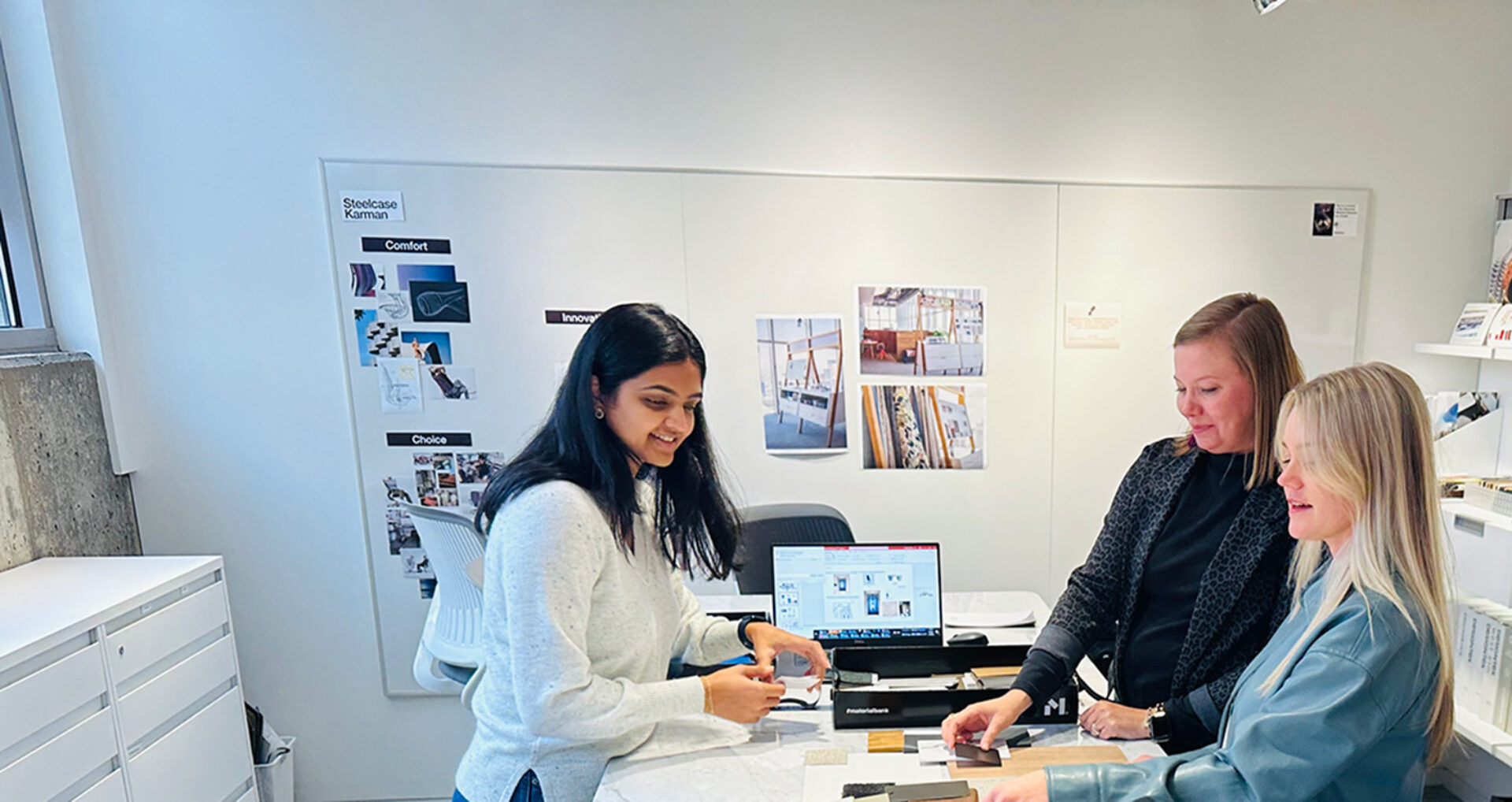(Above: Saloni Patel at work. Image courtesy of Saloni Patel)
Every May, we honor the heritage of Asian Americans, Native Hawaiians, and Pacific Islanders, all of whom have played a pivotal role in shaping American culture and history for generations. IIDA asked some of our members to share their stories and experiences as AAPI designers shaping our collective futures. This year, we spoke to Saloni Patel, IIDA, a creative designer at Empire Office and member of the IIDA Georgia Chapter, Hao Phung, Assoc. IIDA, AIA, an interior architectural designer at Gensler and VP of Action for the IIDA Illinois Chapter, and Deepa Venkat, IIDA, Assoc AIA, project manager for Bergmeyer and IIDA New England President.
Responses have been lightly edited for length and clarity.
Saloni Patel, IIDA
IIDA Georgia
Creative Designer at Empire Office
Tell us about the unique perspectives and experiences of the AAPI community that have, in your opinion, helped shape America broadly, and American design specifically.
Saloni Patel: People from an AAPI background have played a significant role in shaping America’s history, including in the realm of design. One aspect that sets AAPI designers apart is their rich cultural heritage—which often influences their design aesthetics and approaches—from traditional Asian art forms like calligraphy, origami, textiles, and pottery to modern interpretations that blend East and West. This fusion of cultural elements often results in innovative, visually striking designs that resonate with audiences worldwide.

IIDA Georgia
Creative Designer at Empire Office
What unique barriers do AAPI designers face? What progress have you seen?
SP: Some AAPI designers have faced stereotypes or assumptions about their design aesthetics or abilities, based on their cultural background. This can present obstacles in networking and navigating the design industry.
Are there ways that your heritage or cultural background inform your practice?
SP: My designs are always drawn from India’s beautiful textiles, vibrant colors, intricate patterns, and flora and fauna. Designs drawn from natural elements have a calming effect and emphasize eco-design. Indian architecture reflects the country’s diverse cultural and historical influences, ranging from ancient civilizations like the Indus Valley Civilization. Indo-Islamic, Dravidian, and colonial architectural styles have left a lasting impact on India and beyond.
What are you currently inspired by?
SP: My recent inspiration is drawn from my visit to Chichén Itzá, the ancient Maya city located in Yucatán, Mexico, and a visit to the site of the Incan civilization in Peru. Both have me so fascinated—from the cultures to the architecture that emphasized sustainability and eco-friendliness, which are increasingly relevant in contemporary design practice.
Hao Phung, Assoc. IIDA, AIA
VP of Action, Illinois Chapter
Interior Architectural Designer, Gensler
Tell us about the unique perspectives and experiences of the AAPI community that have, in your opinion, helped shape America broadly, and American design specifically.
Hao Phung: Like many other cultures, I believe AAPI designers often integrate their own stories into the western influences of American design culture. Between arts and architecture, fashion and technology, AAPI designers often pull from their dual cultural identities, often from immigrant roots.

VP of Action, Illinois Chapter
Interior Architectural Designer, Gensler
What unique barriers do AAPI designers face? What progress have you seen?
HP: AAPI underrepresentation is still a problem that needs prioritizing in the commercial interior design community. However, I believe the AAPI community itself must shift the mindset, often found in older generations, that creative fields are less valuable than scientific professions.
In the larger design industry, we need to change the notion that interior designers are just picking furniture and finishes. In reality, we impact much more than the aesthetic of a space—we influence behaviors and enhance wellbeing.
Are there ways that your heritage or cultural background inform your practice?
HP: I grew up in a house that was used as a model home, which included European-inspired furniture sets, floral Roman shades, wallpaper frames, and curated finishes. My family infused Asian and Buddhist belongings throughout and it quickly became a unique blend of American design aesthetics with Asian cultural and religious objects. Through those lived experiences, I often find myself striking a balance between the minimal and meditative Zen-style of Buddhism and the vibrancy of reds and golds symbolizing prosperity from Chinese culture. I translate that into a purposeful design approach—without overdesigning beyond the clients’ needs.
What are you currently inspired by?
HP: As a regional inclusive design champion at Gensler, I’m inspired to design empathic spaces in all typologies. I believe my dual-cultural identity lends itself to fuse various voices into a cohesive user experiences. When we can design spaces for everyone through inclusive design, each space is much more impactful than designing for a singular voice.
Deepa Venkat, IIDA, Assoc AIA
IIDA New England President
Project Manager, Bergmeyer
Tell us about the unique perspectives and experiences of the AAPI community that have, in your opinion, helped shape America broadly, and American design specifically.
Deepa Venkat: Asian and Pacific Islander contributions to American design have been rooted in cultural heritage—these cultures have long histories of craftsmanship and artistic traditions that have influenced design aesthetics in the United States. Indian-American interior designers bring a blend of tradition and modernity to their work, infusing spaces with warmth, color, and cultural elements inspired by Indian art, textiles, and furniture design. They design interiors that reflect a fusion of East and West; prioritize comfort, functionality, and aesthetic appeal; and contribute to the diversity of interior design styles in America.
AAPI designers bring their experiences and perspectives to the table, infusing their work with a blend of tradition and innovation. Reflecting the diverse and multicultural nature of American society, their designs celebrate the richness of cultural traditions while also pushing boundaries and challenging stereotypes.

IIDA New England President
Project Manager, Bergmeyer
What unique barriers do AAPI designers face? What progress have you seen?
DV: Recognition and visibility remain barriers to building a reputation and establishing a strong presence in the competitive American design industry. Access to resources that are essential for professional growth and success in our industry, such as mentorship and networking opportunities, are still lacking, preventing designers from establishing themselves, promoting their work, stepping up to leadership positions, and pursuing creative projects.
Despite these barriers, there has been progress in recent years towards greater recognition and representation. Increased diversity and inclusivity initiatives within the design industry, as well as growing appreciation for multicultural perspectives and global design influences, have created opportunities for AAPI designers to showcase their talent and creativity on a broader platform.
Are there ways that your heritage or cultural background informs your practice?
DV: India is a diverse and multicultural country, with a rich tapestry of languages, religions, and regional traditions. My cultural background and heritage deeply influence and inspire my design aesthetics, values, and creative processes and uniquely shape my design sensibilities. It allows me to contribute to the diverse and multicultural landscape of our industry. I strongly believe that our surroundings directly influence the quality of our lives, whether in the workplace, at home, or in the public spaces in between.
What are you currently inspired by?
DV: I often find inspiration in personal experiences, memories, and stories, which shape design narratives and aesthetic choices. Some key inspirations that motivate me include:
Courtyard design. This traditional concept in Indian architecture, where nature serves as a powerful source of inspiration, has found its way into our current commercial design. Courtyards provide natural light, ventilation, and a sense of openness, which creates inviting spaces for relaxation and social interaction while evoking a sense of tranquility, mindfulness, or spiritual connection.
Sustainable design practices. Traditional Indian architecture often incorporates sustainable design principles that prioritize natural ventilation, passive cooling techniques, and the use of locally sourced materials. My focus has been to draw inspiration from these principles to create environmentally conscious spaces that minimize energy consumption and promote sustainability.






